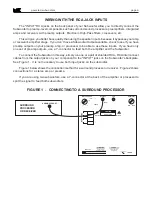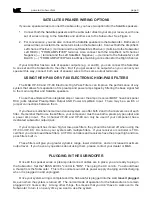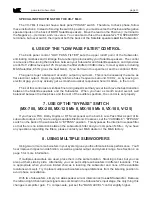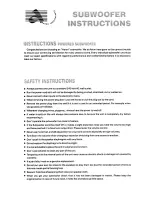
page 12
powered subwoofers
9. HOME THEATRE USAGE
If you are using your Subwoofer in a multichannel Home Theatre system, make sure you are using
the Subwoofer Output jack to connect your subwoofer. Check "Use of the Bypass Switch" above, as
well as M&K's System Setup Guide on page 17.
Compared to music sources, in some cases, you may prefer the subwoofer set to a higher
playback level for video sources. This may occur when video sources (especially older films and some
television) have very little deep bass present. You may also want to exaggerate the effect to make
spectacular video sources even more impressive!
When your subwoofer is going to be located close to a television set, remember to leave 2 - 3 feet
of clearance between the television and subwoofer, unless the subwoofer is magnetically shielded
(MX-700 and V-125 only).
CONNECTING THE SUBWOOFER TO A SURROUND
SOUND RECEIVER OR PROCESSOR:
The preferred connection from a surround sound amp or controller is from a SUBWOOFER
OUTPUT (or MONO) RCA jack. This connection insures that a full bass signal is fed to the subwoofer.
If your component doesn't have a subwoofer output jack, connect the Subwoofer to the front Left and
Right channel speaker outputs (do not use the Center channel speaker output).
VERY IMPORTANT: When the Subwoofer is connected to the Left and Right amplifier outputs
using speaker wires, the Center channel WIDE/NORMAL switch MUST be set to the NORMAL mode.
If the switch is set to the WIDE mode, the bass content of the Center channel will not be fed to the
Subwoofer, and a significant amount of the bass in the material you are listening to will be lost.
10. SPECIAL INSTALLATION NOTES
MX-700, MX-200, MX-125 Mk II, MX-105 Mk II, VX-100:
An enclosed hardware kit contains four black metal spikes, threaded at one end and tapering to
a sharp point at the other. Depending on their orientation, they can be used either as spikes or rubber
feet. Do not use the spiked feet on hardwood or tile floors. They can damage the floor surface.
By mounting these spikes into the threaded inserts mounted in the bottom of the Subwoofer, you
can elevate the Subwoofer, and on carpet, couple it more tightly to that floor. On hardwood, tile, or
concrete, the spikes should be inverted, with the point mounted facing into the cabinet. One of the black
rubber feet provided should then be pressed over the exposed flat end of the foot.
The threaded inserts are found in the four corners of the cabinet's bottom. The inserts are 1/4 -
20, that is, 1/4 inch in diameter and 20 threads per inch. This is compatible with the most spikes,
"cones," "tip-toes," etc. offered by manufacturers of specialized speaker feet.
To properly secure the feet to the cabinet, you must use the provided washer and jamb nut on the
threaded portion of the foot. The washer goes first, with the nut over it, holding the washer securely
in place. This prevents damage to the spike and the threaded insert in case something moves the
cabinet sideways.





































